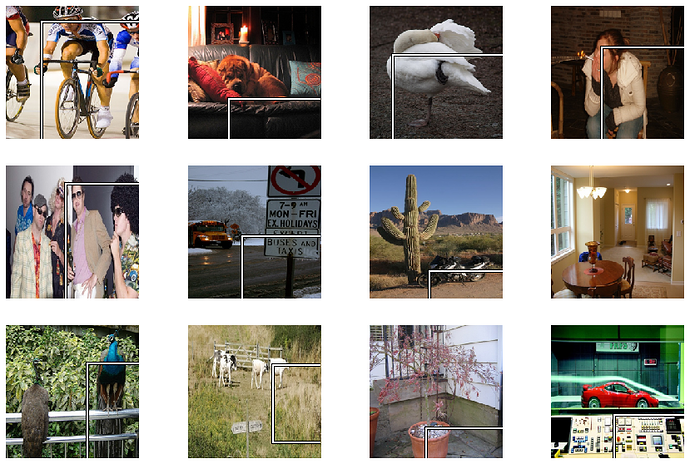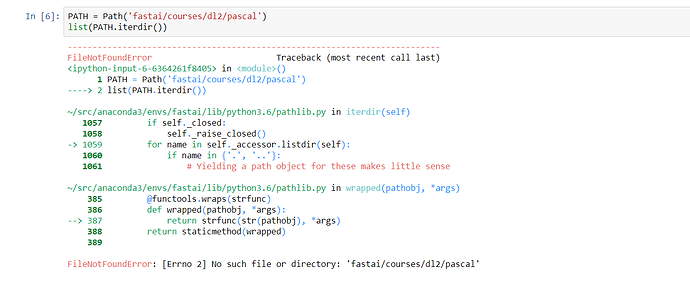Yes, I’ve realized this coords problem too, but can’t solve it yet.
Don’t understand for what we need a random_px_rect() function
@ramesh - very helpful thanks.
@naman-bhalla same results
Yes, encounter the same error, thanks for the solution, it works without the tfm_y parameter specified.
It is not the solution, I think.
Results of prediction of the fitted net are very poor which is expected because of wrong labels.
Yes, the problem definitely appears to be a result of the bounding box, I modified the random_px_rect function and changed the last two lines from:
Y[rows, cols] = 1
return Y
to
try:
Y[rows, cols] = 1
except:
print("Error for Image size: {} bounding box: {:.0f}:{:.0f} , {:.0f}:{:.0f}".format(x.shape, y[0],y[1],y[2],y[3]))
return Y
and got the following results when it runs:
Error for Image size: (224, 298, 3) bounding box: 109:106 , 268:198
Error for Image size: (224, 298, 3) bounding box: 86:287 , 374:499
Error for Image size: (224, 298, 3) bounding box: 208:252 , 374:499
Error for Image size: (224, 282, 3) bounding box: 25:25 , 371:474
Error for Image size: (224, 298, 3) bounding box: 17:163 , 374:499
Error for Image size: (276, 224, 3) bounding box: 68:16 , 465:301
Error for Image size: (224, 298, 3) bounding box: 34:22 , 374:499
Error for Image size: (224, 298, 3) bounding box: 156:131 , 374:480
Error for Image size: (298, 224, 3) bounding box: 383:198 , 482:374
Error for Image size: (224, 298, 3) bounding box: 2:49 , 374:499
Error for Image size: (224, 277, 3) bounding box: 69:60 , 347:499
Error for Image size: (224, 231, 3) bounding box: 104:55 , 382:399
Error for Image size: (224, 298, 3) bounding box: 12:74 , 374:499
Error for Image size: (224, 291, 3) bounding box: 40:35 , 350:442
In the bounding box passed into the function, the bottom/right row exceeds the image rows…
if you replace the print statement with “pass” the function will run and your results will correlate pretty well (loss 30.671 to jeremy’s 201.5) results.
This is awesome! Thanks a bunch
Hey all!
I was getting this error when using pathlib:
OSError: Error handling image at: data\pascal\VOC2007\JPEGImages\000012.jpg
in the pascal notebook when running:
im = open_image(IMG_PATH/im0_d[FILE_NAME]).
I fixed it by using an f-string.
im = open_image(f'{IMG_PATH/im0_d[FILE_NAME]}')
Hope this helps someone.
If I figure out why pathlib isn’t working properly, I’ll report back.
UPDATE: I updated fastai library to the latest and this fixed my issues.
If you are using a remote server like Im where you can’t copy/paste/write directly onto the http-ssh-client then do something like this.
- Download the file directly to your computer.
- Run
python -m SimpleHTTPServer 8000where you downloaded theshfile - Run
ngrok http 8000(you can get it from ngrok.com)
Download it with a more writable reference to your user wget http://random.ngrok.io/pascal_download.sh, then chmod +x pascal_download.sh and ./pascal_download.sh.
Well, it seems taht there exist TfmType.NO, TfmType.PIXEL and TfmType.COORD, and the previous argument, the only one that show no error is TfmType.NO wich is the default.
For CropType there is RANDOM, CENTER ,NO.
So the line for me is tfms = tfms_from_model(f_model, sz, crop_type=CropType.NO, tfm_y=TfmType.NO)
It is actually expected that No won’t show any error as the dimensions of images weren’t affected. But, often it is necessary to get images to same dimension, so I feel it is a library bug that the annotations aren’t being changed so as to reflect change in image.
Assuming that’s your own github handle, where did you get / how did you build the json files corresponding to the dataset ?
EDIT: Ah, never mind. I found it mentioned in the external datasets for COCO here. http://cocodataset.org/#external
Great stuff coming  but is there any chance we’ll see deep learning applied to problem other than computer vision or NLP? I see a lot of papers being released on time series and dealing with ts is what profesional Data scientists do most of the time. I would like to see more stuff like rossmann or what this guy did
but is there any chance we’ll see deep learning applied to problem other than computer vision or NLP? I see a lot of papers being released on time series and dealing with ts is what profesional Data scientists do most of the time. I would like to see more stuff like rossmann or what this guy did  .
.
Regarding time series and structured data, I don’t really have anything to add beyond what’s in the Machine Learning (preview) course and the Rossmann lessons. Other than the idea of feature generation using an auto-encoder (which may only be useful for anonymized datasets - I’m not sure, but I haven’t seen it applied usefully elsewhere yet) I don’t know what else I’d say!..
Similarly, I was wondering whether we will cover GANs in this part of the course like in version 1?
Yup hope to.
Awesome. I played around with GANs a little in the last few months. I think they are fascinating. But I found the training process sort of random and the choice of discriminator loss function (Wasserstein, L2, log, …) very confusing. Very much looking forward to it!
@ramesh thank you very much. I am able to get all the files into the directory fastai/courses/dl2/pascal/. However, I get an error when running the following. Do you have a suggestion?
Thank you,
Ben

